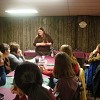Student-Wives Fall Evening Education Series Concludes - 11/18/08
On Tuesday, November 18, Dr. Mary Ford, Ph.D., concluded this semester's Wives' Evening Education classes on the topic, "Spirituality within Hermeneutics & Patristics".
(4 images)
In a two-part lecture series on November 4 and 18, Mary Ford, Ph.D. presented the lecture “Spirituality Within Hermeneutics and Patristics” as part of the Wives' Evening Education Series. The first part of the lecture defined exegesis and its purpose, while the second presented the two types of interpretation, literal and allegorical.
What is exegesis? Broadly speaking, it means “interpretation.” Dr. Mary pointed out how knowledge of the context and our own presuppositions greatly influence the way we interpret Scripture. It is helpful to acquaint oneself with the history, languages, and social customs that form the world view of the human authors of Scripture. However, it is imperative that we submit our own intellectual and even spiritual approach to Holy Scripture to the principles of interpretation handed down to us by the Fathers of the Church. If we allow the Fathers to guide us in our understanding of Scripture, then we can enter into the true purpose of God’s written revelation—not only to inform our minds, but to transform our lives.
What is the purpose of interpretation? Dr. Mary explained the ultimate purpose of Scripture and its interpretation is theosis (deification). Scripture is not an object to look at, but is rather like glasses that correct our poor vision. It gives us freedom from the necessities of fallen human nature (including death) and freedom from the negative passions. Being holy and virtuous is our true nature, and we can only achieve it in Christ as revealed in the Scripture and taught by the Church.
There are two levels of interpretation, literal and spiritual (allegorical). Dr. Mary pointed out that the literal interpretation is not necessarily less spiritual than the allegorical. The most spiritual truth of our Faith, “Christ rose from the dead,” is a literal truth. Church fathers did not dismiss the literal interpretation and used it together with the allegorical.
Allegorical interpretation is a never-ending source of meaning, said Dr. Mary. It should be properly grounded in Tradition in order to cultivate virtue. All possible true interpretations are intended by God, even though the authors may not be necessarily aware of them. Even the reality that we see around us has an allegorical character because it leads to contemplating the invisible and the spiritual. We are being called to see Christ in everyone. In order to do this we are required to develop an allegorical approach to life.
The lecture was interspersed with examples from the writings of the Church Fathers and the lives of the saints. Some of these saints lived centuries ago, while others were our contemporaries. It was edifying to see how they spoke the same truths.
At the end of each session there were questions and answers. We shared our own experiences with interpretation and how our own backgrounds influenced the way we read and interpret Scripture. Dr. Mary offered gentle encouragement to everyone. We should not be intimidated by the complexities of Scripture, but approach it with a pure heart and desire to be transformed by Our Lord's grace.
Velislava Franta, Wife of 1st year Seminarian Todd Franta (OCA)
|
| |||||||||||||
Physical Address:
178 St. Tikhon's Road
Waymart, PA 18472
Mailing Address:
Post Office Box 130
South Canaan, PA 18459
Phone: 570-561-1818





